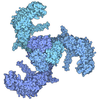+ Open data
Open data
- Basic information
Basic information
| Entry | Database: PDB / ID: 9dwn | |||||||||||||||||||||||||||
|---|---|---|---|---|---|---|---|---|---|---|---|---|---|---|---|---|---|---|---|---|---|---|---|---|---|---|---|---|
| Title | hTHIK1 Cryo-EM structure in GDN detergent | |||||||||||||||||||||||||||
 Components Components | Potassium channel subfamily K member 13 | |||||||||||||||||||||||||||
 Keywords Keywords | MEMBRANE PROTEIN / KCNK13 (THIK1) K2P ion channel dimer / CHS/GDN detergent / HEK293GnTi- | |||||||||||||||||||||||||||
| Function / homology |  Function and homology information Function and homology informationregulation of excitatory synapse pruning / Tandem pore domain halothane-inhibited K+ channel (THIK) / regulation of NLRP3 inflammasome complex assembly / Phase 4 - resting membrane potential / potassium ion leak channel activity / regulation of resting membrane potential / outward rectifier potassium channel activity / monoatomic ion channel complex / potassium channel activity / potassium ion transmembrane transport ...regulation of excitatory synapse pruning / Tandem pore domain halothane-inhibited K+ channel (THIK) / regulation of NLRP3 inflammasome complex assembly / Phase 4 - resting membrane potential / potassium ion leak channel activity / regulation of resting membrane potential / outward rectifier potassium channel activity / monoatomic ion channel complex / potassium channel activity / potassium ion transmembrane transport / protein heterodimerization activity / metal ion binding / identical protein binding / plasma membrane Similarity search - Function | |||||||||||||||||||||||||||
| Biological species |  Homo sapiens (human) Homo sapiens (human) | |||||||||||||||||||||||||||
| Method | ELECTRON MICROSCOPY / single particle reconstruction / cryo EM / Resolution: 3.2 Å | |||||||||||||||||||||||||||
 Authors Authors | Riel, E.B. / Riegelhaupt, P.M. | |||||||||||||||||||||||||||
| Funding support |  United States, 2items United States, 2items
| |||||||||||||||||||||||||||
 Citation Citation |  Journal: Proc Natl Acad Sci U S A / Year: 2025 Journal: Proc Natl Acad Sci U S A / Year: 2025Title: The cryo-EM structure and physical basis for anesthetic inhibition of the THIK1 K2P channel. Authors: Elena B Riel / Weiming Bu / Thomas T Joseph / Leila Khajoueinejad / Roderic G Eckenhoff / Paul M Riegelhaupt /  Abstract: THIK1 tandem pore domain (K2P) potassium channels regulate microglial surveillance of the central nervous system and responsiveness to inflammatory insults. With microglia recognized as critical to ...THIK1 tandem pore domain (K2P) potassium channels regulate microglial surveillance of the central nervous system and responsiveness to inflammatory insults. With microglia recognized as critical to the pathogenesis of neurodegenerative diseases, THIK1 channels are putative therapeutic targets to control microglia dysfunction. While THIK channels can principally be distinguished from other K2Ps by their distinctive inhibitory response to volatile anesthetics (VAs), molecular details governing THIK channel gating remain largely unexplored. Here, we report a 3.2 Å cryo-electron microscopy structure of the THIK1 channel in a closed conformation. A central pore gate located directly below the THIK1 selectivity filter is formed by inward-facing TM4 helix tyrosine residues that occlude the ion conduction pathway. VA inhibition of THIK requires closure of this central pore gate. Using a combination of anesthetic photolabeling, electrophysiology, and molecular dynamics simulation, we identify a functionally critical THIK1 VA binding site positioned between the central gate and a structured section of the THIK1 TM2/TM3 loop. Our results demonstrate the molecular architecture of the THIK1 channel and elucidate critical structural features involved in regulation of THIK1 channel gating and anesthetic inhibition. | |||||||||||||||||||||||||||
| History |
|
- Structure visualization
Structure visualization
| Structure viewer | Molecule:  Molmil Molmil Jmol/JSmol Jmol/JSmol |
|---|
- Downloads & links
Downloads & links
- Download
Download
| PDBx/mmCIF format |  9dwn.cif.gz 9dwn.cif.gz | 108.6 KB | Display |  PDBx/mmCIF format PDBx/mmCIF format |
|---|---|---|---|---|
| PDB format |  pdb9dwn.ent.gz pdb9dwn.ent.gz | 81.8 KB | Display |  PDB format PDB format |
| PDBx/mmJSON format |  9dwn.json.gz 9dwn.json.gz | Tree view |  PDBx/mmJSON format PDBx/mmJSON format | |
| Others |  Other downloads Other downloads |
-Validation report
| Summary document |  9dwn_validation.pdf.gz 9dwn_validation.pdf.gz | 1.3 MB | Display |  wwPDB validaton report wwPDB validaton report |
|---|---|---|---|---|
| Full document |  9dwn_full_validation.pdf.gz 9dwn_full_validation.pdf.gz | 1.3 MB | Display | |
| Data in XML |  9dwn_validation.xml.gz 9dwn_validation.xml.gz | 29.7 KB | Display | |
| Data in CIF |  9dwn_validation.cif.gz 9dwn_validation.cif.gz | 44.7 KB | Display | |
| Arichive directory |  https://data.pdbj.org/pub/pdb/validation_reports/dw/9dwn https://data.pdbj.org/pub/pdb/validation_reports/dw/9dwn ftp://data.pdbj.org/pub/pdb/validation_reports/dw/9dwn ftp://data.pdbj.org/pub/pdb/validation_reports/dw/9dwn | HTTPS FTP |
-Related structure data
| Related structure data |  47258MC M: map data used to model this data C: citing same article ( |
|---|---|
| Similar structure data | Similarity search - Function & homology  F&H Search F&H Search |
- Links
Links
- Assembly
Assembly
| Deposited unit | 
|
|---|---|
| 1 |
|
- Components
Components
| #1: Protein | Mass: 34818.398 Da / Num. of mol.: 2 Source method: isolated from a genetically manipulated source Details: C-terminal truncation after residue S309 / Source: (gene. exp.)  Homo sapiens (human) / Gene: KCNK13 / Cell line (production host): HEK293S GnTi- / Production host: Homo sapiens (human) / Gene: KCNK13 / Cell line (production host): HEK293S GnTi- / Production host:  Homo sapiens (human) / References: UniProt: Q9HB14 Homo sapiens (human) / References: UniProt: Q9HB14#2: Sugar | ChemComp-NAG / #3: Chemical | ChemComp-K / #4: Water | ChemComp-HOH / | Has ligand of interest | Y | Has protein modification | Y | |
|---|
-Experimental details
-Experiment
| Experiment | Method: ELECTRON MICROSCOPY |
|---|---|
| EM experiment | Aggregation state: PARTICLE / 3D reconstruction method: single particle reconstruction |
- Sample preparation
Sample preparation
| Component | Name: THIK1 ion channel dimer / Type: COMPLEX / Details: C-terminally truncated THIK1 ion channel dimer / Entity ID: #1 / Source: RECOMBINANT | ||||||||||||||||||||
|---|---|---|---|---|---|---|---|---|---|---|---|---|---|---|---|---|---|---|---|---|---|
| Molecular weight | Experimental value: NO | ||||||||||||||||||||
| Source (natural) | Organism:  Homo sapiens (human) Homo sapiens (human) | ||||||||||||||||||||
| Source (recombinant) | Organism:  Homo sapiens (human) / Strain: HEK293 / Cell: HEK293S GNTi- / Plasmid: pEG Homo sapiens (human) / Strain: HEK293 / Cell: HEK293S GNTi- / Plasmid: pEG | ||||||||||||||||||||
| Buffer solution | pH: 8 | ||||||||||||||||||||
| Buffer component |
| ||||||||||||||||||||
| Specimen | Conc.: 2.4 mg/ml / Embedding applied: NO / Shadowing applied: NO / Staining applied: NO / Vitrification applied: YES | ||||||||||||||||||||
| Specimen support | Grid material: GOLD / Grid mesh size: 300 divisions/in. / Grid type: Quantifoil R1.2/1.3 | ||||||||||||||||||||
| Vitrification | Instrument: FEI VITROBOT MARK IV / Cryogen name: ETHANE / Humidity: 100 % / Chamber temperature: 294 K |
- Electron microscopy imaging
Electron microscopy imaging
| Experimental equipment |  Model: Titan Krios / Image courtesy: FEI Company |
|---|---|
| Microscopy | Model: TFS KRIOS |
| Electron gun | Electron source:  FIELD EMISSION GUN / Accelerating voltage: 300 kV / Illumination mode: FLOOD BEAM FIELD EMISSION GUN / Accelerating voltage: 300 kV / Illumination mode: FLOOD BEAM |
| Electron lens | Mode: BRIGHT FIELD / Nominal magnification: 105000 X / Nominal defocus max: 2600 nm / Nominal defocus min: 500 nm / Cs: 2.7 mm |
| Specimen holder | Cryogen: NITROGEN / Specimen holder model: FEI TITAN KRIOS AUTOGRID HOLDER |
| Image recording | Electron dose: 48.54 e/Å2 / Film or detector model: GATAN K3 (6k x 4k) / Num. of grids imaged: 2 / Num. of real images: 14246 |
- Processing
Processing
| EM software |
| ||||||||||||||||||||||||||||||||
|---|---|---|---|---|---|---|---|---|---|---|---|---|---|---|---|---|---|---|---|---|---|---|---|---|---|---|---|---|---|---|---|---|---|
| CTF correction | Type: PHASE FLIPPING AND AMPLITUDE CORRECTION | ||||||||||||||||||||||||||||||||
| Symmetry | Point symmetry: C1 (asymmetric) | ||||||||||||||||||||||||||||||||
| 3D reconstruction | Resolution: 3.2 Å / Resolution method: FSC 0.143 CUT-OFF / Num. of particles: 168294 / Symmetry type: POINT | ||||||||||||||||||||||||||||||||
| Refine LS restraints |
|
 Movie
Movie Controller
Controller



 PDBj
PDBj






